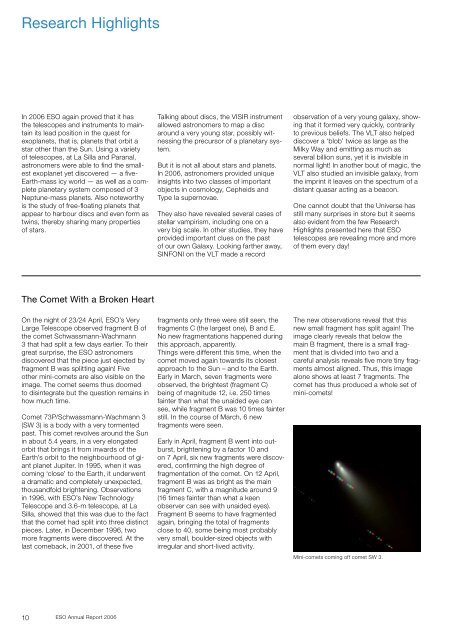Untitled - ESO
Untitled - ESO
Untitled - ESO
Create successful ePaper yourself
Turn your PDF publications into a flip-book with our unique Google optimized e-Paper software.
Research Highlights<br />
In 006 <strong>ESO</strong> again proved that it has<br />
the telescopes and instruments to maintain<br />
its lead position in the quest for<br />
exoplanets, that is, planets that orbit a<br />
star other than the Sun. Using a variety<br />
of telescopes, at La Silla and Paranal,<br />
astronomers were able to find the smallest<br />
exoplanet yet discovered — a five-<br />
Earth-mass icy world — as well as a complete<br />
planetary system composed of 3<br />
Neptune-mass planets. Also noteworthy<br />
is the study of free-floating planets that<br />
appear to harbour discs and even form as<br />
twins, thereby sharing many properties<br />
of stars.<br />
The Comet With a Broken Heart<br />
On the night of 3/ 4 April, <strong>ESO</strong>’s Very<br />
Large Telescope observed fragment B of<br />
the comet Schwassmann-Wachmann<br />
3 that had split a few days earlier. To their<br />
great surprise, the <strong>ESO</strong> astronomers<br />
discovered that the piece just ejected by<br />
fragment B was splitting again! Five<br />
other mini-comets are also visible on the<br />
image. The comet seems thus doomed<br />
to disintegrate but the question remains in<br />
how much time.<br />
Comet 73P/Schwassmann-Wachmann 3<br />
(SW 3) is a body with a very tormented<br />
past. This comet revolves around the Sun<br />
in about 5.4 years, in a very elongated<br />
orbit that brings it from inwards of the<br />
Earth’s orbit to the neighbourhood of giant<br />
planet Jupiter. In 1995, when it was<br />
coming ‘close’ to the Earth, it underwent<br />
a dramatic and completely unexpected,<br />
thousandfold brightening. Observations<br />
in 1996, with <strong>ESO</strong>’s New Technology<br />
Telescope and 3.6-m telescope, at La<br />
Silla, showed that this was due to the fact<br />
that the comet had split into three distinct<br />
pieces. Later, in December 1996, two<br />
more fragments were discovered. At the<br />
last comeback, in 001, of these five<br />
10<br />
<strong>ESO</strong> Annual Report 006<br />
Talking about discs, the VISIR instrument<br />
allowed astronomers to map a disc<br />
around a very young star, possibly witnessing<br />
the precursor of a planetary system.<br />
But it is not all about stars and planets.<br />
In 006, astronomers provided unique<br />
insights into two classes of important<br />
objects in cosmology, Cepheids and<br />
Type Ia supernovae.<br />
They also have revealed several cases of<br />
stellar vampirism, including one on a<br />
very big scale. In other studies, they have<br />
provided important clues on the past<br />
of our own Galaxy. Looking farther away,<br />
SINFONI on the VLT made a record<br />
fragments only three were still seen, the<br />
fragments C (the largest one), B and E.<br />
No new fragmentations happened during<br />
this approach, apparently.<br />
Things were different this time, when the<br />
comet moved again towards its closest<br />
approach to the Sun – and to the Earth.<br />
Early in March, seven fragments were<br />
observed, the brightest (fragment C)<br />
being of magnitude 1 , i.e. 50 times<br />
fainter than what the unaided eye can<br />
see, while fragment B was 10 times fainter<br />
still. In the course of March, 6 new<br />
fragments were seen.<br />
Early in April, fragment B went into outburst,<br />
brightening by a factor 10 and<br />
on 7 April, six new fragments were discovered,<br />
confirming the high degree of<br />
fragmentation of the comet. On 1 April,<br />
fragment B was as bright as the main<br />
fragment C, with a magnitude around 9<br />
(16 times fainter than what a keen<br />
observer can see with unaided eyes).<br />
Fragment B seems to have fragmented<br />
again, bringing the total of fragments<br />
close to 40, some being most probably<br />
very small, boulder-sized objects with<br />
irregular and short-lived activity.<br />
observation of a very young galaxy, showing<br />
that it formed very quickly, contrarily<br />
to previous beliefs. The VLT also helped<br />
discover a ‘blob’ twice as large as the<br />
Milky Way and emitting as much as<br />
several billion suns, yet it is invisible in<br />
normal light! In another bout of magic, the<br />
VLT also studied an invisible galaxy, from<br />
the imprint it leaves on the spectrum of a<br />
distant quasar acting as a beacon.<br />
One cannot doubt that the Universe has<br />
still many surprises in store but it seems<br />
also evident from the few Research<br />
Highlights presented here that <strong>ESO</strong><br />
telescopes are revealing more and more<br />
of them every day!<br />
The new observations reveal that this<br />
new small fragment has split again! The<br />
image clearly reveals that below the<br />
main B fragment, there is a small fragment<br />
that is divided into two and a<br />
careful analysis reveals five more tiny fragments<br />
almost aligned. Thus, this image<br />
alone shows at least 7 fragments. The<br />
comet has thus produced a whole set of<br />
mini-comets!<br />
Mini-comets coming off comet SW 3.

















